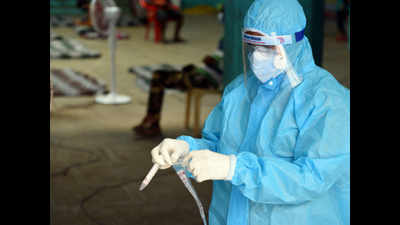- News
- City News
- lucknow News
- Uttar Pradesh: Covid found in staff of 25 of 668 hospitals in random survey
Trending
This story is from June 22, 2020
Uttar Pradesh: Covid found in staff of 25 of 668 hospitals in random survey
A little over 1% of government health staff tested randomly for Covid-19 were found positive for the infection in the ongoing surveillance exercise undertaken by the state health department.

Representative image
LUCKNOW: A little over 1% of government health staff tested randomly for Covid-19 were found positive for the infection in the ongoing surveillance exercise undertaken by the state health department.
“The state is committed towards the containment of coronavirus. For this, we launched the exercise to see the status of coronavirus in vulnerable pockets. Hospitals and health workers were also tested recently and we found the presence of positive cases in 25 of the 668 hospitals (or 3.7%) hospitals,” said additional chief secretary, Amit Mohan Prasad.
Health workers, especially those engaged in public dealing, were tested Prasad said.“As many as 4,577 samples were taken from the hospitals covered and 51 of them were found positive. On the overall scale, this is about 1.1% of the strength.”
Prasad said that that the 51 covid positive cases were found in across 25 hospitals in 17 districts namely: Mau, Sant Kabir Nagar, Shamli, Muzaffarnagar, Sultanpur, Varanasi, Moradabad, Pratapgarh, Mainpuri, Agra, Ghaziabad, Jalaun, Kanpur Nagar, Meerut, Baghpat, Amroha and Gonda.
Earlier, the random tests were conducted among slum dwellers.
“The state is committed towards the containment of coronavirus. For this, we launched the exercise to see the status of coronavirus in vulnerable pockets. Hospitals and health workers were also tested recently and we found the presence of positive cases in 25 of the 668 hospitals (or 3.7%) hospitals,” said additional chief secretary, Amit Mohan Prasad.
Health workers, especially those engaged in public dealing, were tested Prasad said.“As many as 4,577 samples were taken from the hospitals covered and 51 of them were found positive. On the overall scale, this is about 1.1% of the strength.”
Prasad said that that the 51 covid positive cases were found in across 25 hospitals in 17 districts namely: Mau, Sant Kabir Nagar, Shamli, Muzaffarnagar, Sultanpur, Varanasi, Moradabad, Pratapgarh, Mainpuri, Agra, Ghaziabad, Jalaun, Kanpur Nagar, Meerut, Baghpat, Amroha and Gonda.
He also said that instructions have been passed on to the district health officers to conduct a second round of assessment in the hospitals where covid-19 cases were found. “Preventive activities must also be undertaken in these districts,” he said.
Earlier, the random tests were conducted among slum dwellers.
End of Article
FOLLOW US ON SOCIAL MEDIA











